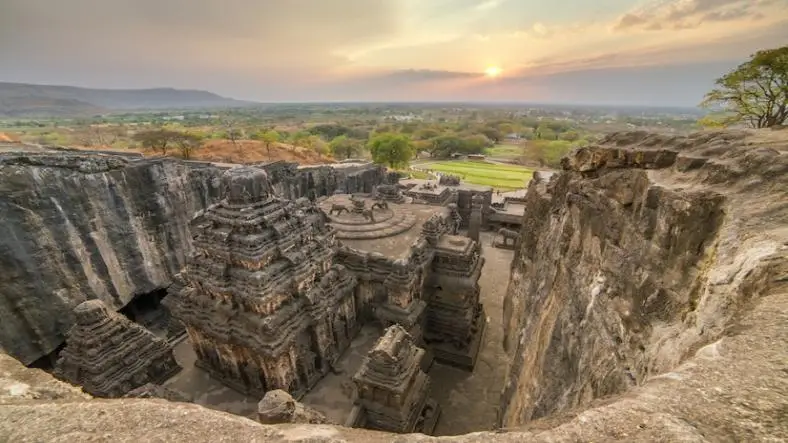The Kailasa Temple at Ellora, carved from a single massive rock in Maharashtra, India, stands as one of the greatest architectural and engineering marvels of the ancient world. Dedicated to Lord Shiva, the temple forms part of the Ellora Caves, a UNESCO World Heritage Site. Unlike most temples that were built by adding material, this one was created through monolithic excavation—workers removed an estimated 200,000 tons of rock, carving downward from the top of the basalt hill.
While the Kailasa Temple is an astonishing achievement in itself, researchers and historians remain fascinated by the enigmatic signs of incompletion that surround the monument. Despite its grandeur, parts of the complex appear unfinished, raising questions about its construction, purpose, and sudden halt.
An Architectural Wonder Without Parallel
The temple, attributed to the Rashtrakuta king Krishna I (8th century CE), was designed to replicate Mount Kailash, the mythological abode of Lord Shiva. Its scale and precision are astounding:
- A central shrine with a towering vimana (spire) nearly 30 meters high
- Vast courtyards, pillared halls, and subsidiary shrines
- Intricate sculptures depicting scenes from the Ramayana, Mahabharata, and Puranic mythology
- Elephants and lions carved directly into the bedrock as structural supports
The most remarkable feature is the vertical excavation technique—workers began at the top of the rock and carved downward, a method that left little room for error. This ensured the temple’s structural stability but also raises questions about the planning and execution methods available more than 1,200 years ago.
Signs of Incompletion
Although breathtaking in its grandeur, closer examination reveals that parts of the Kailasa Temple appear unfinished or abandoned midway:
- Certain sculptures remain roughly hewn, lacking the fine detailing seen elsewhere.
- Pillars in some halls look partially shaped, as if the carving was halted.
- Portions of the surrounding rock face exhibit unpolished surfaces, suggesting work was stopped before completion.
This inconsistency has led researchers to debate whether the temple was truly finished or left incomplete for reasons still unknown.
Possible Explanations for the Halt
Several theories attempt to explain why parts of the temple remain unfinished:
1. Change in Royal Patronage
If the temple was commissioned under Krishna I, his successors may not have shared the same enthusiasm for the project. A shift in political priorities or depletion of state resources could have led to a sudden slowdown or halt.
2. Overambitious Design
The sheer scale of the Kailasa Temple suggests that it may have been too ambitious to complete fully within a single reign. The final detailing might have been postponed with the intention of resuming later—a continuation that never happened.
3. Invasion or External Disruption
Some scholars propose that external pressures, such as regional conflicts or invasions, could have interrupted construction. However, there is little direct archaeological evidence of a violent disruption at Ellora during this period.
4. Geological Challenges
Working with solid basalt rock was a feat of engineering, but it is possible that workers encountered structural weaknesses, cracks, or collapses that made further carving unfeasible in certain sections.
Methods of Construction – A Continuing Puzzle
How ancient builders achieved such precision remains one of the greatest enigmas. Without advanced machinery, artisans would have relied on iron chisels, hammers, and sheer manpower. The coordination required to remove thousands of tons of rock with such accuracy is extraordinary.
Some fringe theories even suggest the use of lost technologies or influences from outside India. While mainstream historians attribute the temple’s creation to remarkable human skill and organization, the absence of detailed records leaves room for speculation.
Religious and Cultural Significance
Even in its seemingly unfinished state, the Kailasa Temple holds immense symbolic power. It represents not just a shrine to Lord Shiva, but also a cosmic mountain, a union of architecture and mythology. The vastness of the structure may have been intended to embody divine grandeur, serving as a political and spiritual statement of the Rashtrakutas’ power.
Conclusion
The Kailasa Temple of Ellora remains both a triumph and a mystery. Its breathtaking scale testifies to the ingenuity of ancient Indian artisans, while its apparent incompletion poses unanswered questions. Was it an overambitious dream curtailed by time, politics, or natural challenges? Or is what we see today exactly what its creators intended?
For researchers, the Kailasa Temple continues to be not just an object of admiration, but a reminder of how much of history still lies buried in stone and silence.
Thanks for reading the article, for more unsolved mysteries related articles read our peoples blog articles.














